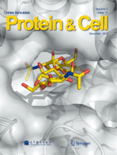
TRENDS IN BIOCHEMICAL SCIENCES
Scope & Guideline
Pioneering Insights for Tomorrow’s Research
Introduction
Aims and Scopes
- Biochemical Mechanisms and Pathways:
The journal consistently publishes research that elucidates the fundamental biochemical mechanisms underpinning cellular processes, including metabolism, signaling pathways, and protein interactions. - Structural Biology and Protein Dynamics:
There is a strong emphasis on structural studies, including techniques like X-ray crystallography and cryo-electron microscopy, to understand protein structure-function relationships and dynamics. - Molecular and Cellular Biology:
The journal explores molecular biology at the cellular level, including gene expression regulation, RNA biology, and the implications of these processes in cellular function and disease. - Biochemical Engineering and Therapeutics:
Research exploring the engineering of biochemical pathways for therapeutic applications, including drug development and targeting disease mechanisms, is a core focus area. - Interdisciplinary Approaches:
The journal promotes interdisciplinary research that combines biochemistry with fields like bioinformatics, systems biology, and computational biology to address complex biological questions.
Trending and Emerging
- Immunometabolism and Disease:
Recent publications indicate a growing interest in the intersection of immunology and metabolism, particularly in understanding how metabolic pathways influence immune responses in diseases such as cancer and autoimmune disorders. - RNA Biology and Epitranscriptomics:
There is an increasing focus on RNA biology, including the roles of non-coding RNAs and RNA modifications, in gene regulation and cellular function, highlighting the complexity of gene expression regulation. - Biochemical Engineering and Therapeutic Applications:
Emerging themes in the engineering of biochemical pathways for therapeutic development are gaining traction, particularly in the context of gene therapy and synthetic biology. - Biomolecular Condensates and Phase Separation:
Research on biomolecular condensates and the role of phase separation in cellular organization and function has surged, reflecting a broader interest in understanding cellular compartmentalization. - Machine Learning and Computational Approaches in Biochemistry:
The integration of machine learning and computational methods to predict biochemical interactions and analyze large datasets is becoming increasingly relevant, showcasing the journal's commitment to incorporating modern technologies into biochemical research.
Declining or Waning
- Classical Enzyme Kinetics:
Research centered on traditional enzyme kinetics appears to be declining, possibly due to the rise of more sophisticated methodologies and computational models that provide deeper insights into enzyme mechanisms. - Basic Plant Biochemistry:
Although plant biochemistry remains important, the journal has seen a reduction in publications focused solely on basic biochemical processes in plants, suggesting a shift towards more applied research in agricultural biotechnology. - Single-Molecule Techniques:
While single-molecule techniques have been revolutionary, the number of publications focusing exclusively on these methods has tapered off, possibly due to the maturation of the field and the integration of these techniques into broader biochemical studies. - Historical Perspectives in Biochemistry:
There seems to be a waning interest in historical reviews and perspectives in biochemistry, as the journal increasingly prioritizes cutting-edge research and innovative methodologies. - Traditional Biochemical Assays:
The reliance on traditional biochemical assays, such as colorimetric assays, appears to be decreasing in favor of high-throughput and more sophisticated analytical techniques.
Similar Journals

BIOCHEMICAL AND BIOPHYSICAL RESEARCH COMMUNICATIONS
Exploring the molecular mechanisms that shape our world.BIOCHEMICAL AND BIOPHYSICAL RESEARCH COMMUNICATIONS, published by Academic Press Inc Elsevier Science, stands as a leading periodical in the fields of biochemistry, biophysics, cell biology, and molecular biology. With an ISSN of 0006-291X and an E-ISSN of 1090-2104, this esteemed journal has been a pivotal platform for the dissemination of groundbreaking research since its inception in 1959, continuing to publish influential findings through at least 2024. It holds a commendable Q2 ranking in Biochemistry and Q1 status in Biophysics as of 2023, reflecting its high impact and relevance in the field, supported by its strong Scopus rankings—ranking #43 in Biophysics and maintaining a presence in the top quartiles of several related categories. Although it is not an open-access journal, it provides critical insights and essential data that cater to researchers, professionals, and students keen on advancing their understanding of complex biochemical and biophysical processes. Its significant contributions to the scientific community underscore the importance of this journal as a reference point for innovative research and collaborative discourse.

MOLECULAR AND CELLULAR BIOCHEMISTRY
Pioneering Insights in Biochemistry and MedicineMOLECULAR AND CELLULAR BIOCHEMISTRY, an esteemed journal published by SPRINGER, serves as a prominent platform in the fields of biochemistry and molecular biology. With a history of dissemination since 1973, this journal has made significant contributions to the understanding of biochemical processes at the molecular level. The MOLECULAR AND CELLULAR BIOCHEMISTRY journal focuses on a myriad of topics including but not limited to cellular biochemistry, clinical biochemistry, and interdisciplinary approaches in medicine, boasting a commendable categorization in the 2023 Scopus ranks where it falls under Q3 in Cell Biology, Q2 in Clinical Biochemistry, Q1 in Medicine (miscellaneous), and Q2 in Molecular Biology. Although the journal is not open access, it provides access options through institutional subscriptions, making valuable research accessible to a wider audience. With its rigorous peer-review process and high impact within the scientific community, this journal aims to advance knowledge and stimulate exploration in biochemical research, making it essential reading for researchers, professionals, and students alike.

Journal of Biochemistry
Your essential resource for biochemical advancements.Journal of Biochemistry, published by Oxford University Press, is a prestigious academic journal that has been at the forefront of biochemical research since its inception in 1922. With an ISSN of 0021-924X and an E-ISSN of 1756-2651, this journal serves as a platform for disseminating high-quality research in the fields of biochemistry, molecular biology, and medicine, holding impressive rankings such as Q2 in Biochemistry and Medicine (miscellaneous) in 2023. As of 2024, the journal continues to explore significant topics in these areas, offering valuable insights for researchers, professionals, and students alike. The journal does not currently offer open access, but it remains a vital resource for anyone in the biochemical community seeking to stay updated on the latest discoveries and advancements. With its rich history and dedication to scientific excellence, the Journal of Biochemistry is an indispensable part of the scholarly landscape.

Protein & Cell
Transforming Understanding of Proteins and Cells for TomorrowProtein & Cell, published by Oxford University Press, is a distinguished international journal focusing on cutting-edge research in the fields of biochemistry, biotechnology, cell biology, and drug discovery. This open access journal, active since 2014, is dedicated to disseminating innovative findings that advance our understanding of protein functions and cellular processes, making it an essential resource for researchers, professionals, and students alike. With an impressive 2023 impact factor reflected in its Q1 ranking across multiple categories such as Biochemistry, Drug Discovery, and Cell Biology, 'Protein & Cell' stands at the forefront of scientific research, driving collaboration and discussion in the scientific community. Researchers can access the journal freely online, fostering a global exchange of knowledge and contributing to significant advancements in medicine and biotechnology. Located in the United Kingdom, the journal strives to be a pivotal platform for impactful research that influences future studies and applications.

CURRENT PROTEIN & PEPTIDE SCIENCE
Empowering Researchers with Vital Insights in BiochemistryCURRENT PROTEIN & PEPTIDE SCIENCE, published by Bentham Science Publishers, is a pivotal journal dedicated to the dynamic and rapidly evolving fields of protein and peptide research. With an ISSN of 1389-2037 and an E-ISSN of 1875-5550, this esteemed journal serves as a platform for disseminating cutting-edge findings from various disciplines, including biochemistry, cell biology, and molecular biology. Recognized for its influence with a 2023 Scopus ranking placing it within the top quartiles of its categories—Q3 in Biochemistry, Q4 in Cell Biology, and Q2 in Medicine—the journal not only enhances the visibility of critical research but also supports the academic community in advancing our understanding of the molecular foundations of life. Established in 2000 and running through 2024, CURRENT PROTEIN & PEPTIDE SCIENCE is positioned to cater to the interests of researchers, professionals, and students alike, providing them with open access to vital knowledge that fuels innovation and scientific inquiry in the United Arab Emirates and beyond.

BIOCHEMICAL JOURNAL
Elevating Biochemical Knowledge for a Global CommunityBIOCHEMICAL JOURNAL, published by Portland Press Ltd, stands as a leading publication in the fields of Biochemistry, Cell Biology, and Molecular Biology, reflecting a commitment to advancing scientific knowledge since its inception in 1945. With a distinguished Q1 ranking across these categories and impressive Scopus rankings, the journal serves as an invaluable resource for researchers, professionals, and students alike, facilitating critical discoveries and innovative research practices. Although not currently offering open access, the journal provides a platform for high-quality peer-reviewed articles, ensuring rigorous standards in the dissemination of biochemical research. Spanning over seven decades and continuing through to 2024, the BIOCHEMICAL JOURNAL fosters an environment where cutting-edge biochemical research thrives, supporting the global scientific community's efforts to address complex biological questions and enhance our understanding of fundamental cellular processes.

Doklady Biochemistry and Biophysics
Fostering Scholarly Discourse in Biochemistry and BiophysicsDoklady Biochemistry and Biophysics is a vital resource for the advancement of knowledge in the fields of biochemistry and biophysics, published by MAIK NAUKA/INTERPERIODICA/SPRINGER. Featuring an ISSN of 1607-6729 and an E-ISSN of 1608-3091, this journal plays a critical role in disseminating research findings and fostering scholarly discourse. Despite its recent ranking in the Q4 quartile for biochemistry and biophysics in 2023, it serves as an essential platform for researchers exploring these intertwined disciplines. The journal’s scope encompasses a wide variety of topics, enhancing the understanding of biochemical processes and physical principles in biological systems. With converged years of publication from 2001 to 2024, it stands as a continual source of knowledge for its readers, who include researchers, professionals, and students alike. While the journal currently does not offer open access options, its contributions remain significant within the scholarly community, illustrated by its competitive Scopus rankings across related fields.

FEBS LETTERS
Pioneering New Ideas in Biochemistry and GeneticsFEBS LETTERS, published by Wiley, is a prestigious journal that has firmly established its place in the fields of biochemistry, biophysics, genetics, molecular biology, cell biology, and structural biology. With an esteemed history dating back to 1968, this journal continues to be a vital resource for researchers and professionals involved in the biological sciences. It boasts impressive quartile rankings, including Q1 statuses in several categories such as Biochemistry and Genetics, reflecting its high impact factor and significant contribution to scientific discourse. FEBS LETTERS provides a platform for innovative findings and critical reviews, fostering the exchange of knowledge and ideas within the scientific community. Although it operates under a subscription model, the journal ensures broad dissemination of groundbreaking research through its rigorous peer-review process. The vibrant discussions encouraged by articles published in FEBS LETTERS aim to inspire current and future generations of scientists to push the boundaries of biological understanding, making it an indispensable resource for anyone dedicated to advancing their knowledge in these dynamic fields.

GENERAL PHYSIOLOGY AND BIOPHYSICS
Bridging Biological Systems with Physical PrinciplesGENERAL PHYSIOLOGY AND BIOPHYSICS, published by AEPRESS SRO, is a pivotal journal in the fields of biophysics and physiology, dedicated to advancing knowledge and fostering research in these increasingly vital disciplines. Established in 1983 and set to converge in 2024, the journal provides a platform for scholarly articles that explore the intricate relationships between biological systems and physical principles. Its current category quartiles include Q3 in Biophysics and Q4 in Physiology, demonstrating a growing influence among researchers, with current Scopus ranks reflecting its commitment to quality and relevance. Despite not being an open-access publication, the journal remains a valuable resource for professionals and students aiming to stay informed on the latest discoveries and methodologies. By supporting interdisciplinary research and innovation, GENERAL PHYSIOLOGY AND BIOPHYSICS plays a crucial role in shaping the understanding of complex biological interactions and applications in medicine.

PROTEIN JOURNAL
Exploring the Frontiers of Protein ScienceProtein Journal, published by Springer, stands as a significant academic resource in the fields of Analytical Chemistry, Biochemistry, Bioengineering, and Organic Chemistry. Since its inception in 1996, the journal has dedicated itself to the dissemination of high-quality research focused on protein chemistry and its biomedical applications. With an impressive impact reflected in its classification as a Q2 journal in Analytical Chemistry and Q3 in both Biochemistry and Bioengineering as of 2023, it provides an essential platform for researchers and practitioners to share their findings. The journal embraces the open-access model, enhancing accessibility to cutting-edge research. The Protein Journal is crucial for academicians, industry professionals, and students, catering to their need for rigorous scientific discourse and innovative discoveries in protein studies. With an established track record of converging over two decades of knowledge and research, it continues to influence and shape the advancements in this vital area of science.